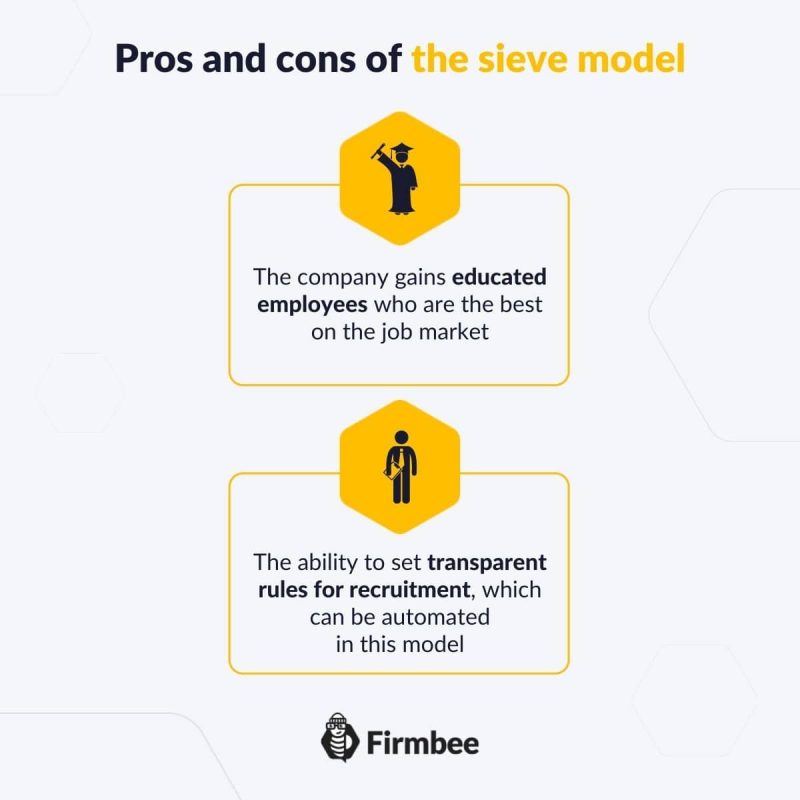The human capital model or the sieve model? Recruitment is an ongoing process, not just a spontaneous action. It can be defined as the procedure of identifying and attracting potential employees to the company. In order to conduct it correctly, it is necessary to have a good understanding of the market and use various recruitment strategies. Read on.
The human capital model or the sieve model? – table of contents:
- The main purpose of the recruitment process
- Sources of recruitment
- The sieve model
- Pros and cons of the sieve model
- The human capital model
- Pros and cons of the human capital model
The main purpose of the recruitment process
The recruitment process consists in attracting a sufficient number of candidates for a given position in the company, and then screening them to select the most suitable one. Recruitment is a multistage process that ends with hiring of a new employee.
Sources of recruitment
There are two sources of recruitment, internal sources and external sources. An organization may fill a vacancy with an employee who already works there or someone from outside the company.
Internal recruitment
Internal recruitment occurs when the recruitment process is directed to existing staff.They are the potential candidates. People who are willing to get promoted, change qualifications or a position are taken into consideration. Internal recruitment is a good way to recognize employees and prove that human resources are the most valuable part of the organization. This process helps to retain the best employees in the company.
External recruitment
External recruitment involves the use of appropriate methods to attract candidates from outside the organization.
The sieve model
The sieve model assumes that each adult is a formed individual who is not subject to further significant change. Therefore, during the recruitment process, an employer following this model looks for competent employees whose qualifications meet the job requirements.
This means reaching out to top candidates only and identifying the most suitable ones among them. Older employees, who have proven to be inefficient, are eliminated. In the sieve model, the crucial thing is the candidate’s job history – their experience, education and achievements. This is quite an unusual approach, since according to most models, the best solution is to constantly invest in employee training and development.

Pros and cons of the sieve model
The main advantage of the sieve model is the fact that the company gains educated employees who are the best on the job market. Another advantage is also the ability to set transparent rules for recruitment, which can be automated in this model.
On the other hand, using this method can lead to low employee attachment to the company and result in high turnover. This, in turn, entails high costs of recruitment which must be repeated periodically. What is more, negative reviews from employees can easily reach potential candidates through online forums and seriously impact your recruitment efforts in the long run.
The human capital model
The human capital model is completely contrary to the sieve model. It assumes that people change and learn throughout their lives. A company using this model relies on young people, often uneducated, but showing potential.
Much attention is paid to the candidate’s predispositions and character traits, whereas certificates, diplomas and degrees are less important. Loyalty, positive attitude and willingness to cooperate are the desired features among job candidates. The target group here are students, graduates and current employees who show potential for promotion.

Pros and cons of the human capital model
A huge advantage for employees is certainly a sense of security in the company and a positive atmosphere at work. Nowadays, stability is very important, and it may become a strong argument when it comes to choosing the particular organization as a future employer.
Employers using this model are focused on the employee. They do not plan layoffs, and they care about employee development and necessary training. In case of any difficulties, they try to provide another position for the employee within the same organization. A sense of security leads to creating a bond with the company, which in turn significantly reduces the employee turnover.
A good employment policy also makes employees more committed, so they perform their tasks with greater efficiency. A friendly atmosphere in the company results in a significant increase in productivity and creativity, which is particularly important in certain sectors.
If you like our content, join our busy bees community on Facebook, Twitter, LinkedIn, Instagram, YouTube.
Author: Nicole Mankin
HR manager with an excellent ability to build a positive atmosphere and create a valuable environment for employees. She loves to see the potential of talented people and mobilize them to develop.


















